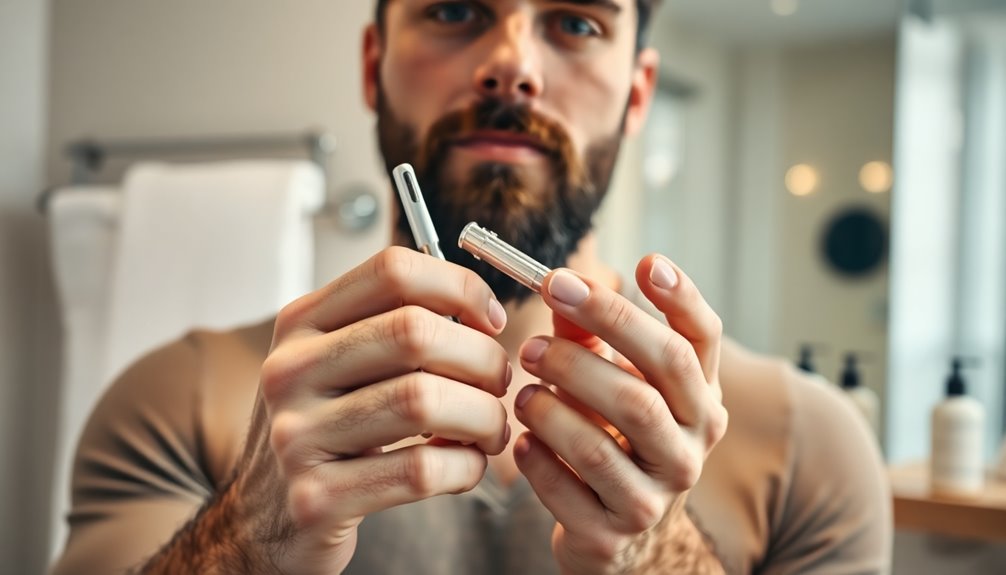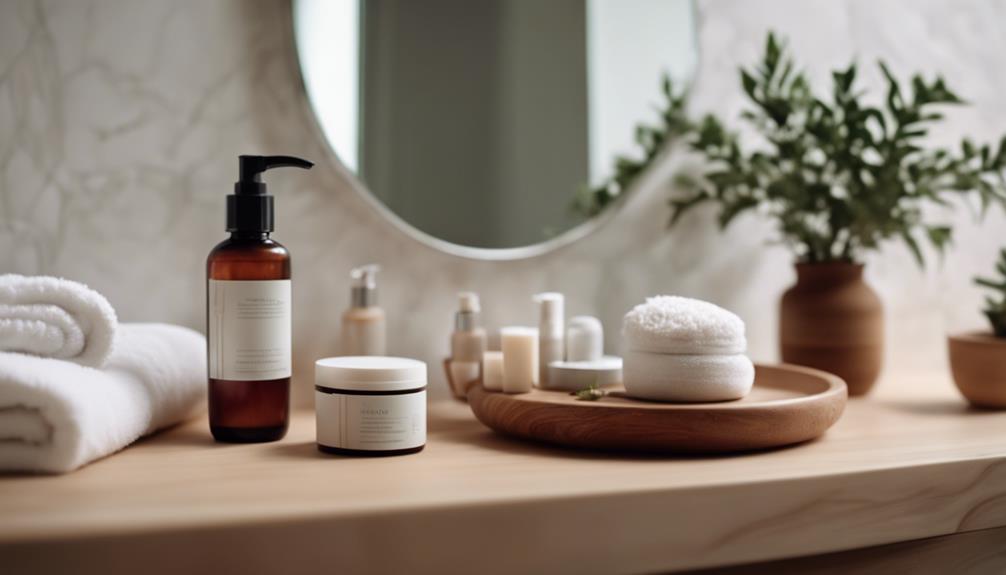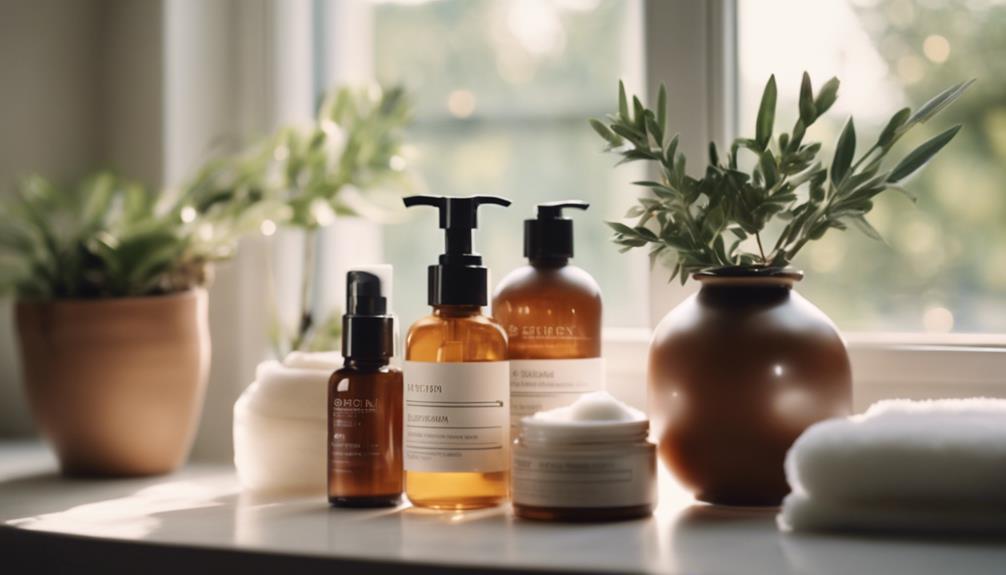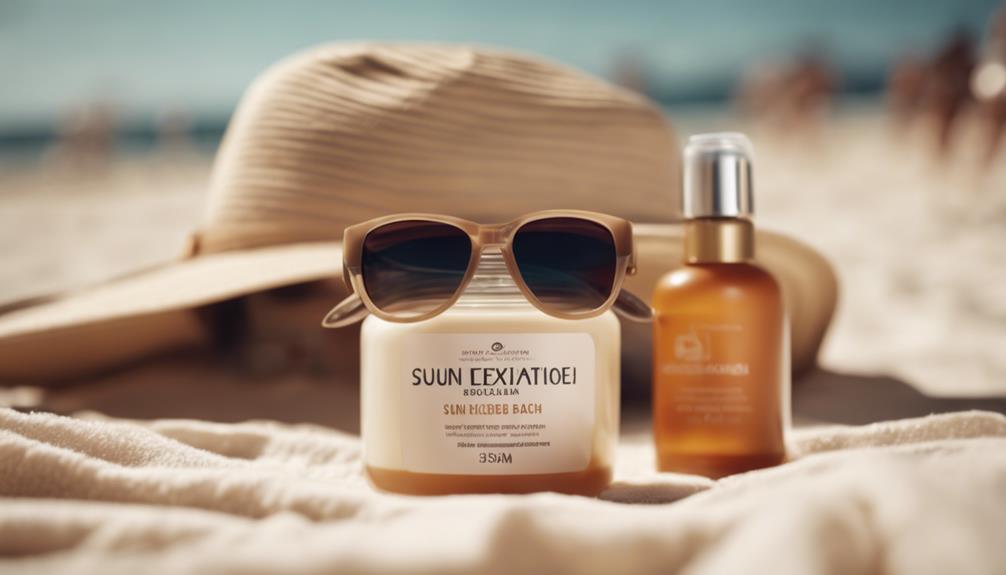Manscaping is more than just a trend; it’s about feeling good and looking sharp. Start by prepping your skin in the shower to avoid irritation. Invest in quality tools like a reliable razor or electric shaver for a clean finish. Remember to trim in the direction of hair growth to prevent bumps, especially in sensitive areas. Choose a style that suits you—whether it’s a trimmed look or a full shave. Regular grooming not only enhances your appearance but also boosts confidence. If you want to ensure you’re impressing her every time, there’s much more to explore. Don’t forget that grooming isn’t just about aesthetics; it can also lead to a more enjoyable personal experience. As you refine your routine, consider investing in some quality grooming products and even gifts that will make her swoon. Enhancing your self-care regimen can elevate not only your look but also the special moments you share together.
Key Takeaways
- Start with proper skin preparation to prevent irritation and ensure a smooth grooming experience.
- Use quality grooming tools like a razor and trimmer for precision and comfort during manscaping.
- Trim hair in the direction of growth and apply shaving balm post-grooming for a clean finish.
- Choose a style that suits you, such as trimmed or brief style, for an attractive appearance.
- Maintain hygiene through regular grooming to enhance confidence and reduce odor, impressing your partner.
Understanding Manscaping Basics
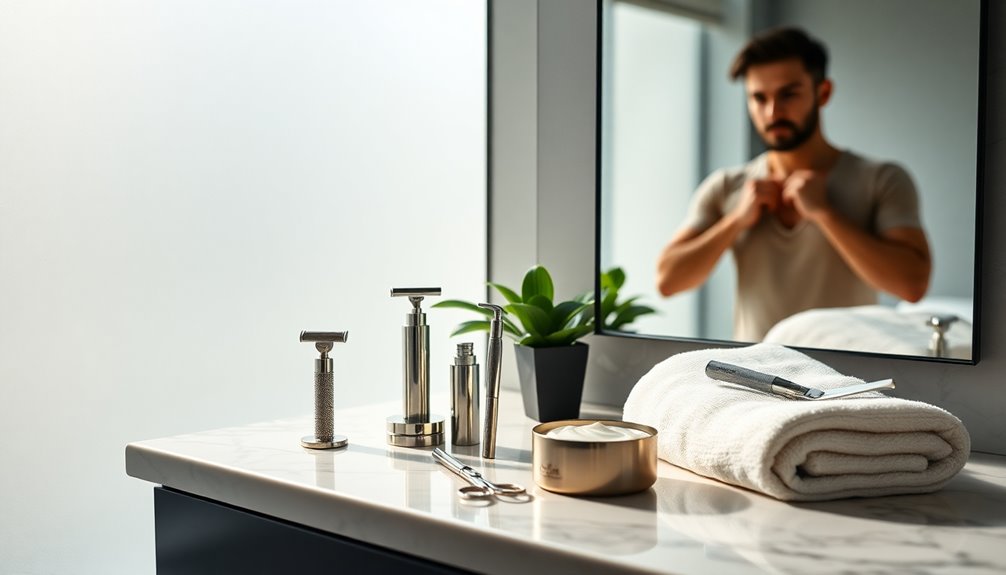
Manscaping basics are essential for maintaining a clean and polished look. Before you start, it's crucial to prepare your skin. Shower, dry off, and let your skin cool down to avoid irritation. Comb through your hair to eliminate knots, and use a mirror to visualize hard-to-reach areas. Always practice caution, especially in sensitive spots, using short, light strokes to minimize risks.
When it comes to trimming, start by cutting hair in the direction of growth, then go against it for a cleaner finish. Use a body groomer with adjustable length settings for precision. For pubic hair, aim to keep it around an inch to maintain a tidy appearance without compromising visual size. Trim chest hair to about a centimeter to prevent itchy regrowth while showcasing muscle definition. Using a specialized trimmer can significantly enhance your overall grooming experience.
If you're considering shaving, use a trimmer first to cut hairs back before using a wet razor for a smoother result. Apply shaving balm and plenty of shave cream for the best outcome. Remember to shave with cold water to keep the skin taut. Regular grooming not only enhances your look but also helps you feel more confident in your skin.
Essential Tools for Grooming
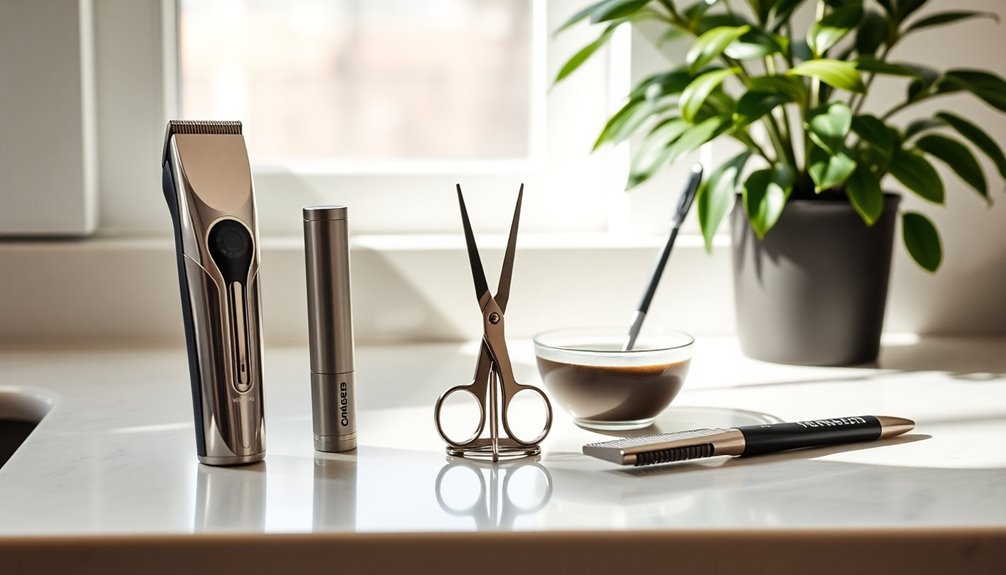
Achieving a polished look requires having the right tools at your disposal. Start with a quality razor or electric shaver for a clean shave and precise beard trimming. Razors offer a close shave, while electric shavers help you shape and groom with ease. Don't forget tweezers for tasks like shaping your eyebrows or removing ingrown hairs; a slanted tip gives you the control you need.
Nail clippers are essential for keeping your nails tidy, and a shampoo brush can enhance your scalp's health while evenly distributing shampoo. For detailing, grooming scissors are invaluable for precise trimming.
When it comes to body grooming, a body groomer or trimmer is a must, as it lets you maintain an even length without the risk of nicks. Waterproof trimmers add convenience, allowing you to groom in the shower. Additionally, regular self-care practices are essential for maintaining your overall grooming routine and ensuring you look your best.
For skincare, invest in a cleansing brush to keep your skin looking fresh and shaving cream or oil to reduce irritation. Lastly, consider beard care products to maintain your facial hair. Having these essential tools will put you on the path to impressing her with your well-groomed appearance.
Effective Trimming and Shaving Techniques
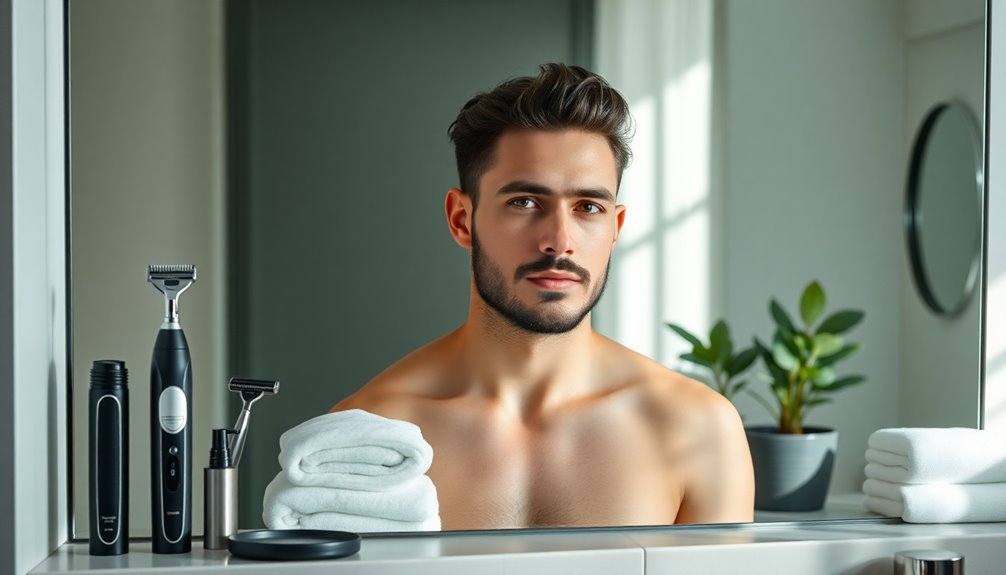
Effective trimming and shaving techniques are essential for maintaining a well-groomed appearance. To start, use a body groomer or beard trimmer to achieve an even length. Always trim in the direction of hair growth to minimize irritation and prevent ingrown hairs. Utilizing guard combs on your electric trimmer can help you adjust hair length and avoid accidental cuts. It's best to trim the area before shaving, as this reduces the risk of razor burn. Additionally, proper technique can help prevent folliculitis, an inflammation of hair follicles caused by irritation.
When it comes to shaving, ensure you shave in the direction of hair growth to prevent irritation and razor bumps. Avoid going back and forth over the same area. A sharp, multi-blade razor is key, so replace blades regularly for optimal performance. Apply shaving cream or gel for moisture and glide. Remember not to pull the skin taut while shaving, as this can lead to irritation.
Before you begin, take a warm shower to loosen dirt and soften hair. After grooming, sterilize your tools with rubbing alcohol and wash your hands and body to prevent infection. Finish with shaving balm to keep the area smooth and irritation-free.
Popular Styles to Consider

After mastering trimming and shaving techniques, it's time to explore the various styles you can adopt for a polished look. One popular option is the Briefs style, where you shave all pubic hair outside your underwear. This keeps hair from sticking out and offers a neat appearance without extensive grooming. If you prefer a low-maintenance approach, consider the Trimmed style, which involves using a pubic hair trimmer to keep your hair short while maintaining a natural look. This style is ideal for those who embrace natural growth without much intervention.
For a more creative touch, you might try the Landing Strip, featuring a single line of hair that adds elegance to your grooming. Alternatively, Designer Stubble lets you express individuality with an even layer of short hair. If you're aiming for a sleek appearance, the Brazilian/Full Monty removes all pubic hair, providing a fresh feel but requiring regular upkeep. The Bald Eagle takes this further by completely eliminating hair for maximum cleanliness and comfort. Each style offers unique benefits, so choose one that aligns with your grooming preferences and lifestyle.
Importance of Hygiene and Comfort
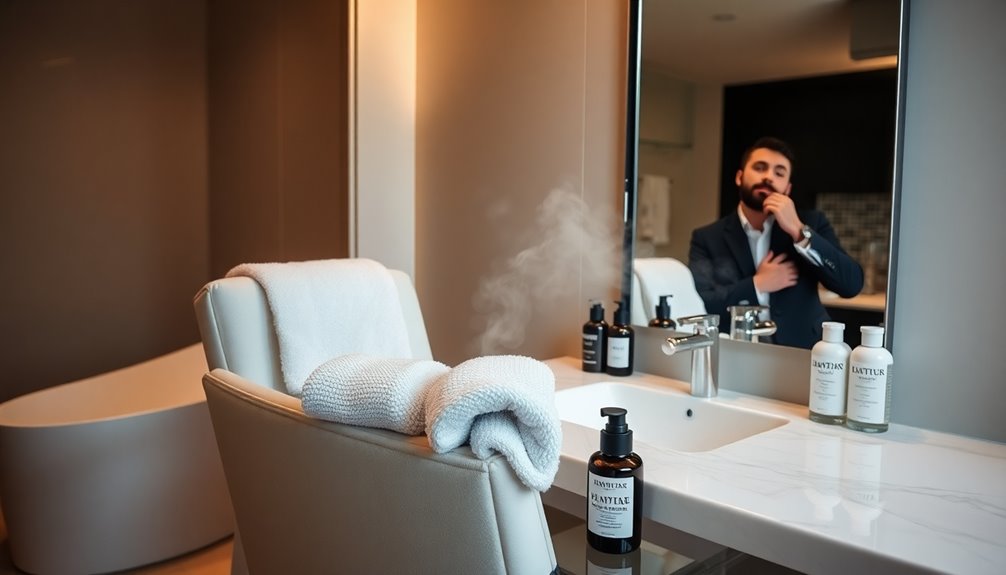
When it comes to manscaping, prioritizing hygiene and comfort is essential for both your health and overall well-being. Trimming or removing body hair helps reduce sweat and odor by allowing your skin to breathe. This step minimizes the environment where odor-causing bacteria thrive, keeping you feeling fresh.
Regular grooming also prevents bacterial and fungal infections by keeping moisture, dirt, and dead skin cells at bay. This is particularly crucial in areas prone to irritation, such as the groin. Moreover, maintaining a trimmed appearance reduces the risk of STDs and yeast infections by limiting the surface area for harmful substances. Additionally, proper grooming can significantly enhance your overall skin health and hygiene.
Post-manscaping, remember to wear loose clothing to avoid friction and irritation. Keeping the area clean and dry is vital, so consider using talcum powder or an antiperspirant. Regular grooming not only improves your hygiene but also enhances your comfort. You'll experience less itching and snagging, and you'll enjoy improved skin sensitivity during intimate moments.
Ultimately, good hygiene and comfort from manscaping contribute to your confidence and peace of mind, allowing you to focus on enjoying life to the fullest.
Frequently Asked Questions
How Often Should I Manscape for Best Results?
To achieve the best results, you should aim to manscape every 7-12 days, adjusting based on your hair growth rate and personal preference. Trimming every 1-2 weeks helps maintain a tidy look, as pubic hair typically grows about ⅛-inch per week. Pay attention to your skin's response and adapt your routine to avoid irritation. Consistency is key, so find a schedule that works for you and stick with it for optimal grooming.
Can Manscaping Lead to Skin Irritation or Ingrown Hairs?
Yes, manscaping can definitely lead to skin irritation and ingrown hairs. If you're using bacteria-covered blades or harsh shaving products, your skin's likely to react negatively. Improper techniques, like shaving against hair growth, can also cause issues. To avoid this, make sure to use clean tools, shave in the direction of hair growth, and apply soothing products afterward. Taking these steps can help keep your skin smooth and irritation-free.
What Are the Benefits of Manscaping Beyond Aesthetics?
Beyond aesthetics, you'll find that manscaping offers several practical benefits. It improves hygiene by reducing sweat and odor, keeping you comfortable and fresh throughout the day. You'll experience increased comfort during physical activities, minimizing chafing and irritation. Additionally, it enhances sensitivity, making intimate moments more enjoyable. Plus, a well-groomed appearance boosts your confidence, positively impacting how you perceive yourself and how others perceive you in social and professional settings.
How Do I Choose the Right Style for My Body Type?
To choose the right style for your body type, consider your natural hair growth patterns and areas with dense hair. Reflect on your comfort with different grooming methods and the level of smoothness you want. Think about how grooming affects muscle definition and overall aesthetics. Finally, experiment with various styles to see what looks best on you, ensuring you maintain a natural appearance that aligns with your personal preferences and lifestyle.
Is Manscaping Considered a Necessity or a Personal Choice?
Manscaping isn't a necessity; it's really a personal choice. You might find it enhances your confidence or aligns with your aesthetic preferences. While some men choose to manscape for cleanliness or partner preferences, it's not required for health or hygiene. Ultimately, it's about what makes you feel good. If you enjoy it and it fits your style, go for it; if not, that's perfectly fine too!
Conclusion
Incorporating manscaping into your routine can make a big difference in how you feel and how others perceive you. By understanding the basics, using the right tools, and mastering your grooming techniques, you'll not only look great but also boost your confidence. Remember, it's all about hygiene and comfort, so choose a style that suits you. With a little effort, you're sure to impress her and feel your best. Go ahead, give it a try!
